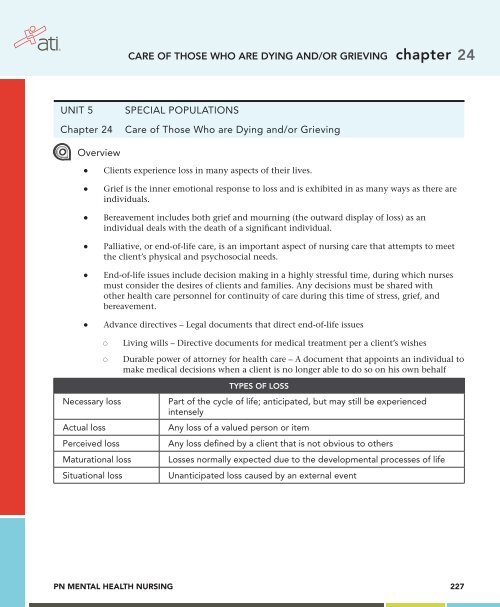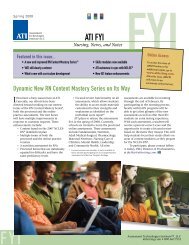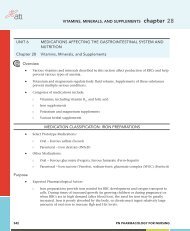chapter 24 - ATI Testing
chapter 24 - ATI Testing
chapter 24 - ATI Testing
Create successful ePaper yourself
Turn your PDF publications into a flip-book with our unique Google optimized e-Paper software.
Care of Those Who are Dying and/or Grieving◯◯Provide an environment that promotes dignity and self-esteem.●●◯◯◯◯◯◯■■■■■■■■Remove products of elimination as soon as possible to maintain a clean and odorfreeenvironment.Provide comfortable clothing.Provide grooming for hair, nails, and skin.Encourage family members to bring in possessions that are meaningful to clients,such as pictures.Encourage use of relaxation techniques (guided imagery and music).Promote decision making in food selection, activities, and health care to involve theclient as much control as possible.Encourage the client to perform ADLs if the ability and desire exist.Psychosocial Care◯◯◯◯◯◯◯◯◯◯◯◯◯◯◯◯Use trained volunteers when appropriate to provide nonmedical care.Use therapeutic communication to develop and maintain a nurse-client relationship.Facilitate understanding of information regarding disease progression and treatmentchoices.Facilitate communication between clients, families, and providers.Encourage clients to participate in religious practices that bring comfort and strength,if appropriate.Assist clients in clarifying personal values to facilitate effective decision making.Encourage clients to use coping mechanisms that have worked in the past.Be sensitive to comments made in the presence of clients who are unconscious, ashearing is the last of the senses that is lost.●●Prevention of Abandonment and Isolation◯◯Prevent the fear of dying alone.●●■■■■■■■■Make presence known by answering call lights in a timely manner and makingfrequent contact.Enter client’s room and speak to the client regularly even if there has not been arequest.Keep clients informed of procedure and assessment times.Allow family members to spend the night.Support for the Grieving Family◯◯◯◯Suggest that family members plan visits in a manner that promotes client rest.Ensure that families receive appropriate information as treatment plans change.232 PN MENTAL HEALTH NURSING
Care of Those Who are Dying and/or Grieving◯◯◯◯◯◯Provide privacy so family members have the opportunity to communicate and expressfeelings among themselves without including the client.Determine family members’ desire to provide physical care. Provide instruction asnecessary.Educate families about physical changes to expect as the client moves closer to death.Client Outcomes●●●●●●The client verbalizes that pain and discomfort are controlled.The client rests comfortably and exhibits minimal signs of distress.The client and family participate in care as much as client and family desires.POSTMORTEM CAREOverview●●●●A nurse is responsible for following federal and state laws regarding requests for organor tissue donation, obtaining permission for autopsy, certification and appropriatedocumentation of the death, and providing safe postmortem (after-death) care.The client’s family now becomes the nurse’s primary focus.Nursing Interventions●●Care of the Body◯◯◯◯◯◯Provide care with respect and compassion while attending to the desires of the clientand family per their cultural, religious, and social practices.Recognize that the provider certifies the client’s death by pronouncing time anddocumenting therapies used, and actions taken prior to the death.Preparing the body for viewing■■■■■■■■■■■■Maintain privacyShave facial hair (if applicable) if desired by the familyRemove all tubes and soiled linens, unless organs are to be donated or it is acoroner’s caseRemove all personal belongings to be given to the familyCleanse and position the body with a pillow under the head, arms outside thesheet and blanket, dentures in place, and eyes closedApply fresh linens and a gownPN MENTAL HEALTH NURSING 233
Care of Those Who are Dying and/or Grieving●●◯◯◯◯■■■■■■Brush/comb the client’s hair, and replace any hair piecesRemove excess equipment and linens from the roomDim the lights and minimize noise to provide a calm environmentViewing considerations include:■■■■■■Asking the family if they would like to remain with the body, and honoring anydecision. This process should not be rushed.Clarifying where the client’s personal belongings should go, either with the bodyor to a designated personAdhering to the same procedures when the deceased is a newborn, while addingthe following:☐☐☐☐☐☐Post viewing■■■■■■Organ DonationSwaddling the infant’s body in a clean blanketTransporting the cradled infant in the nurse’s arms or in a special infantcarrierOffering mementos of the infant (identification bracelets, footprints, cordclamp, lock of hair, photos)Apply identification tags according to the facility’s policy.Complete documentation.Remain aware of visitor and staff sensibilities during transport.◯◯◯◯◯◯◯◯Recognize that request for tissue and organ donation must be made by speciallytrained personnel.Provide support and reinforce education to family members as decisions are beingmade. Use a private area for any family discussions concerning donation.Be sensitive to cultural and religious influences.Maintain ventilatory and cardiovascular support for vital organ retrieval.●●Autopsy Considerations◯◯◯◯◯◯◯◯◯◯The provider typically approaches the family about performing an autopsy.The nurse’s role is to answer the family’s questions and support the family’s choices.Autopsies can be conducted to advance scientific knowledge regarding diseaseprocesses, which can lead to the development of new therapies.The law may require an autopsy to be performed if the death is due to a homicide oran accident, or if the death occurs within <strong>24</strong> hr of hospital admission.Most facilities require that equipment used during medical intervention (tubes)remain in place if an autopsy is planned.234 PN MENTAL HEALTH NURSING
Care of Those Who are Dying and/or GrievingAPPLIC<strong>ATI</strong>ON EXERCISESScenario: An older adult client is accompanied by her adult daughter to the community mentalhealth facility. The client’s husband was killed in a motor vehicle crash over a year ago. The clientreports that she has been unable to continue any of her normal activities. She does not keep thehouse clean, has experienced long bouts of crying every day, and does not see her old friends. Thedaughter asks the nurse if her mother’s behavior is to be expected at this time.1. The nurse should respond by recognizing that the findings demonstrated by the client indicatewhich of the following types of grief?A. NormalB. AnticipatoryC. DysfunctionalD. Disenfranchised2. What clinical findings are present to indicate that the client’s grief is becoming prolonged?3. What further data collection should the nurse make at this time?4. A nurse is caring for a client who is dying. Identify three nursing interventions that the nurse canuse to assist the client in maintaining his dignity and self-esteem during end-of-life care.5. A toddler was brought to the emergency department by rescue squad after having been foundunattended in the swimming pool of an apartment complex. Resuscitation was unsuccessfuland the child was pronounced dead. The parents arrive several minutes later, as the mother wasnotified at her job, and the father was home asleep after having worked the night shift. Howshould the nurse provide support for the parents?236 PN MENTAL HEALTH NURSING
Care of Those Who are Dying and/or GrievingAPPLIC<strong>ATI</strong>ON EXERCISES ANSWER KEYScenario: An older adult client is accompanied by her adult daughter to the community mentalhealth facility. The client’s husband was killed in a motor vehicle crash over a year ago. The clientreports that she has been unable to continue any of her normal activities. She does not keep thehouse clean, has experienced long bouts of crying every day, and does not see her old friends. Thedaughter asks the nurse if her mother’s behavior is to be expected at this time.1. The nurse should respond by recognizing that the findings demonstrated by the client indicatewhich of the following types of grief?A. NormalB. AnticipatoryC. DysfunctionalD. DisenfranchisedClients who are unable to carry out the activities of daily living 6 months after the deathmay be experiencing dysfunctional grief. Normal grief is uncomplicated, and the clientdemonstrates some acceptance 6 months after the loss. Anticipatory grief is a type of griefthat occurs in anticipation of a future loss. Disenfranchised grief is a type of grief thatcannot be publicly recognized.NCLEX ® Connection: Psychosocial Integrity, Grief and Loss2. What clinical findings are present to indicate that the client’s grief is becoming prolonged?The client has bouts of crying every day.Behavior changes include being too tired to keep house clean and seldom leaving home.The client no longer sees her old friends.NCLEX ® Connection: Psychosocial Integrity, Grief and Loss3. What further data collection should the nurse make at this time?Check the client for suicidal ideation, depression, and anxiety.NCLEX ® Connection: Psychosocial Integrity, Grief and LossPN MENTAL HEALTH NURSING 237
Care of Those Who are Dying and/or Grieving4. A nurse is caring for a client who is dying. Identify three nursing interventions that the nurse canuse to assist the client in maintaining his dignity and self-esteem during end-of-life care.Listen to the client’s concerns.Maintain cleanliness and odor control in the client’s physical environment.Allow the client to participate in ADLs, as desired.Provide personal grooming assistance, as necessary.Encourage the client to make decisions regarding food selection, activities, and healthcare.NCLEX ® Connection: Psychosocial Integrity, End-of-Life Care5. A toddler was brought to the emergency department by rescue squad after having been foundunattended in the swimming pool of an apartment complex. Resuscitation was unsuccessfuland the child was pronounced dead. The parents arrive several minutes later, as the mother wasnotified at her job, and the father was home asleep after having worked the night shift. Howshould the nurse provide support for the parents?Provide time for the parents and family members to be with the child in a private area.The room should be arranged so that it is free of equipment and has adequate seating.The child should be prepared to look as normal as possible. If parents request to hold thechild or to take a photograph, assist them to do so. Arrange for the parents to have a lockof their child’s hair, clothing, the hospital identification band, or other personal items. Beavailable to support the parents and answer questions.NCLEX ® Connection: Psychosocial Integrity, End of Life Concepts238 PN MENTAL HEALTH NURSING










